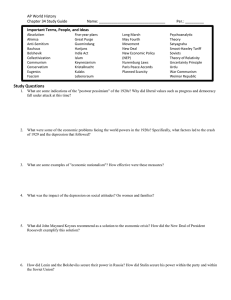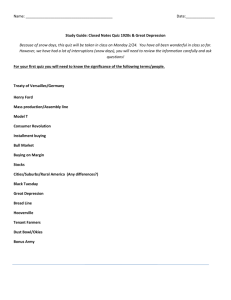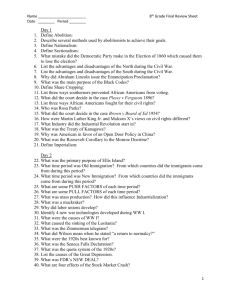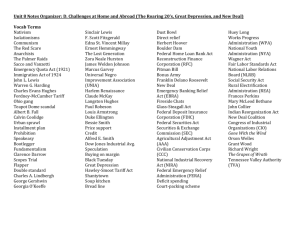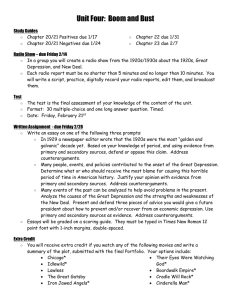The 1920s & 1930s AP World History
advertisement
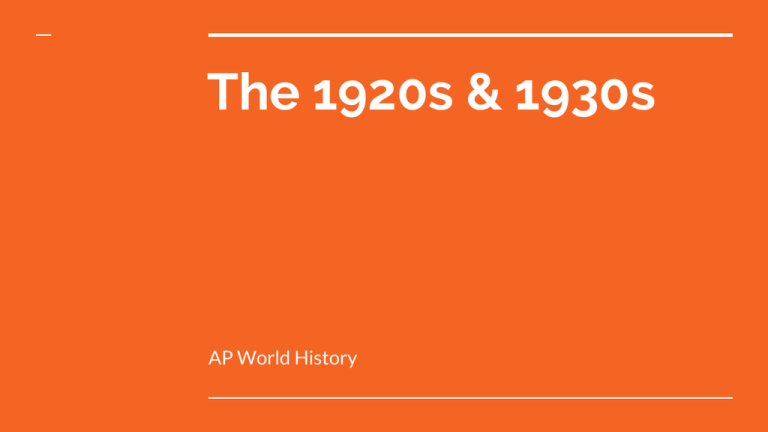
The 1920s & 1930s AP World History League of Nations Created to maintain world peace Forty-two members, twenty-six outside Europe Dominated by UK, France -- used to isolate Germany No power to enforce decisions, but could make suggestions, impose sanctions Powers left out US never joined, Germany not invited for some time USSR ignored; colonies not included Mandate system New Nations of Eastern Europe Created by Treaty of Versailles @ end of World War I Often by force, out of Germany, Austria, Russia, etc. Each state a kaleidoscope of different ethnic groups State building Tried to emulate Western Europe, but no wealth or stability Trying to build nations from scratch Little industry, mostly agrarian Few cities, small middle classes or intellectuals Rise of the United States World War I Put US in position of leadership Became largest industrialized nation, largest center of banking Lent the Allies trillions Left war w/ 2nd largest navy in world, largest army Treaty of Versailles rejected by the Senate US doesn’t join the League of Nations (Wilson is sad) US moves toward isolationism Roaring Twenties Post-War Economic Troubles World War I = expensive Countries spent $180 billion on armaments, boats, warfare Europe’s cost to rebuild = another $150 billion Capitalism used to finance the recovery -- Americans lend Europeans lots of money France had loaned tons of money to Russia, but new Bolshevik government won’t honor debts Germany has to pay reparations from Versailles → Germany borrows $$$ from America and uses it to repay debts to France and Britain Post-War Economic Troubles (2) Germany is in debt, suffers from massive inflation Global market gets tougher Colonies have hard time affording European manufactured goods, so less demand for European goods Nationalism → tariffs and trade barriers Agricultural overproduction → food prices drop Result: harder for European countries to make money to repay war loans By 1929: Central Powers can’t pay reparations to Allies, and Problems in the US in the 1920s U.S. remains physically untouched by WW1 1920s = farms and factories producing more goods than could be sold many Americans do not have enough money to buy these products Europeans make their own products again -- less foreign demand People buying excessively on credit Buying stocks “on margin” Unequal income distribution in U.S. U.S. Stock Market Crash October 1929 -- the stock market crashed in U.S. Stock prices plummeted, peoples’ fortunes wiped out Banks and businesses close as people lose their savings World trade drops 62% in a couple years People lose their jobs → unemployment Unemployment means less money to spend, makes recovery harder Kicks off the Great Depression Worldwide phenomenon -- spread from America to Europe Effects of the Depression Emergence of: Vacant factories Soup kitchens & bread lines, Shantytowns U.S. and Germany hit hardest -- about one-third of available work-force unemployed Factories stop producing A deeper, more prolonged slump than before Effects of Depression: Western Europe and the United States New government-led welfare programs to try and fix it In the U.S., the New Deal under President Franklin Delano Roosevelt Flounders for the first few years of the Great Depression Government programs based on social welfare Greatly increases size of government, restores public confidence Goals: restart economic growth, prevent future problems Relief programs to aid poor, unemployed, elderly Effects of Depression Elsewhere The Soviet Union: mostly unaffected Centralized, command economy Little ties to the West Latin America & other colonial regions Colonies usually dependent on 1-2 products = hit especially hard by the Great Depression Suffered as demand from Europe & U.S. dropped Ex. Chile dependent on copper exports → value drops 80% Governments become more involved in economy Effects of Depression: Fascism Fascist movements in parts of Europe Main idea: destroy the will of the individual, in favor of “the people” Want a unified society (but not one w/o classes, like Communists) Focused on a national identity rooted in extreme nationalism, Intolerance & racism, strong sense of racial identity Popular especially in places where democracy is not very well-established (usually right after WW1) Examples: Germany, Italy Fascism in Germany Immediately following WW1, revolt in Germany as the emperor abdicates the throne Workers’ councils (like the Russian soviets) form in Berlin Conservative middle class in Germany → Instead of a socialist system, creates a conservative democratic republic, the Weimar Republic Economic crisis in Germany By 1932: over six million unemployed Hyperinflation The Cost of a Loaf of Bread in Germany November 1918 1 mark November 1922 163 marks September 1923 1,500,000 marks November 1923 200,000,000,000 marks Fascism in Germany National Socialist Party (Nazis) rise in 1920s Attack parliamentary democracy (the system used in the rest of Western Europe) as corrupt and weak Call for a strong leader & a state greater than the sum of individual interests Supported by business leaders -- attacks unions & socialists Adolf Hitler = leader of Nazis Inspires extreme nationalism, “renewed greatness” for Germany Social Darwinism -- convinced Aryans are most highly evolved race Nazis in Power Built a totalitarian state Exercised direct control over many aspects of German life Eliminated opposition groups through terror, secret police, concentration camps Jews = scapegoats for modern problems, persecuted Foreign policy Withdrew Germany from League of Nations Germany militarizes (violating Treat yof Versailles) Recaptures Rhineland, annexes Austria
